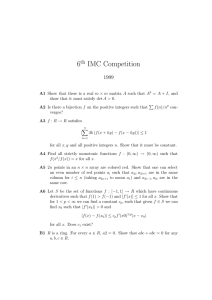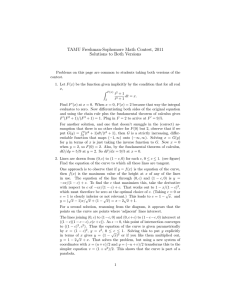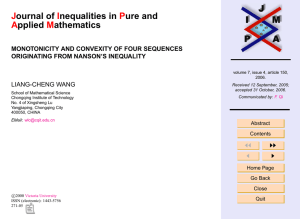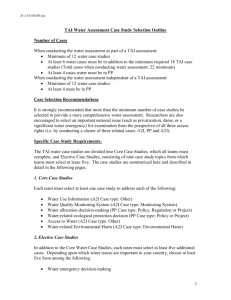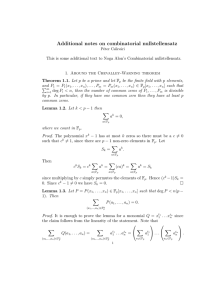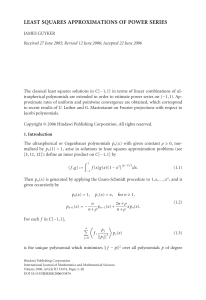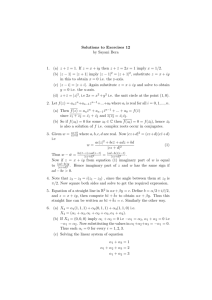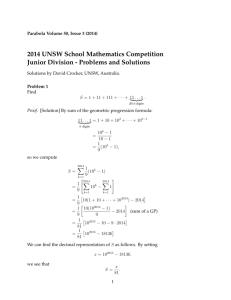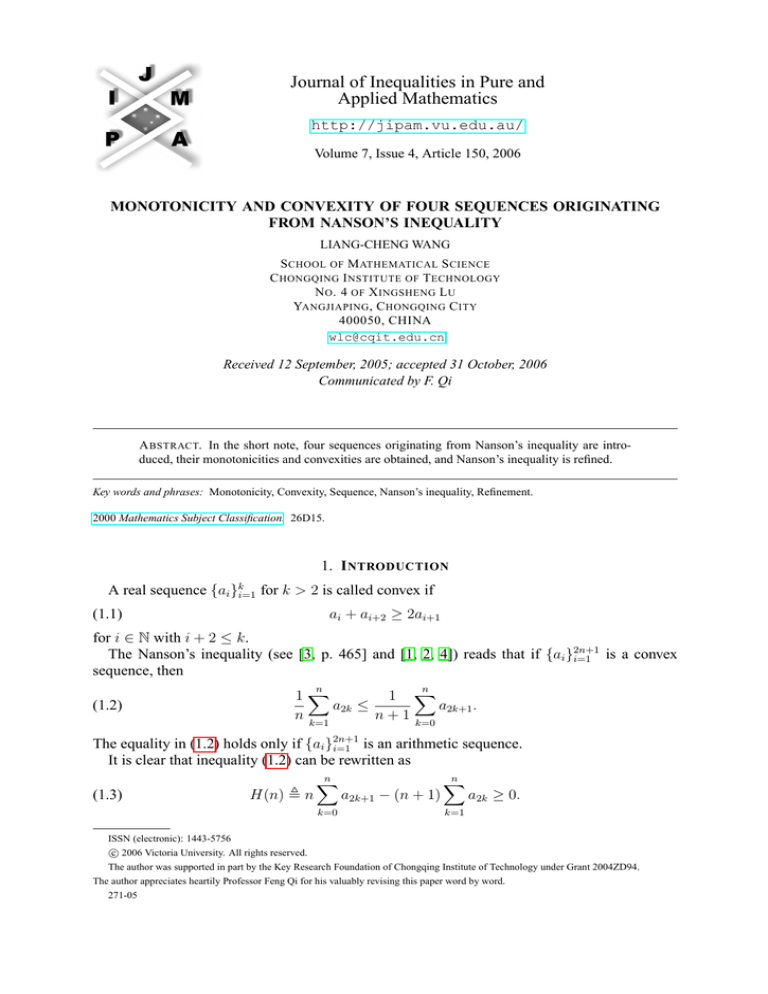
Journal of Inequalities in Pure and
Applied Mathematics
http://jipam.vu.edu.au/
Volume 7, Issue 4, Article 150, 2006
MONOTONICITY AND CONVEXITY OF FOUR SEQUENCES ORIGINATING
FROM NANSON’S INEQUALITY
LIANG-CHENG WANG
S CHOOL OF M ATHEMATICAL S CIENCE
C HONGQING I NSTITUTE OF T ECHNOLOGY
N O . 4 OF X INGSHENG L U
YANGJIAPING , C HONGQING C ITY
400050, CHINA
wlc@cqit.edu.cn
Received 12 September, 2005; accepted 31 October, 2006
Communicated by F. Qi
A BSTRACT. In the short note, four sequences originating from Nanson’s inequality are introduced, their monotonicities and convexities are obtained, and Nanson’s inequality is refined.
Key words and phrases: Monotonicity, Convexity, Sequence, Nanson’s inequality, Refinement.
2000 Mathematics Subject Classification. 26D15.
1. I NTRODUCTION
A real sequence {ai }ki=1 for k > 2 is called convex if
ai + ai+2 ≥ 2ai+1
(1.1)
for i ∈ N with i + 2 ≤ k.
The Nanson’s inequality (see [3, p. 465] and [1, 2, 4]) reads that if {ai }2n+1
i=1 is a convex
sequence, then
n
(1.2)
n
1X
1 X
a2k ≤
a2k+1 .
n k=1
n + 1 k=0
The equality in (1.2) holds only if {ai }2n+1
i=1 is an arithmetic sequence.
It is clear that inequality (1.2) can be rewritten as
(1.3)
H(n) , n
n
X
k=0
a2k+1 − (n + 1)
n
X
a2k ≥ 0.
k=1
ISSN (electronic): 1443-5756
c 2006 Victoria University. All rights reserved.
The author was supported in part by the Key Research Foundation of Chongqing Institute of Technology under Grant 2004ZD94.
The author appreciates heartily Professor Feng Qi for his valuably revising this paper word by word.
271-05
2
L.-C H . WANG
Similar to H(n), it can be introduced for given n ∈ N that
(1.4)
h(m) = (n − m + 1)
n
X
a2k+1 − (n − m + 2)
k=m−1
(1.5)
n
X
a2k
for 1 ≤ m ≤ n + 1,
k=m
" m
#
m
n
X
X
X
1
C(m) =
m
a2i+1 + (n − m)
a2i + (n + 1)
a2i
n(n + 1)
i=0
i=1
i=m+1
for 0 ≤ m ≤ n, and
(1.6)
"
#
n
m−1
n
X
X
X
1
c(m) =
(n − m + 1)
a2i+1 + (n + 1)
a2i + (m − 1)
a2i
n(n + 1)
i=m−1
i=1
i=m
P
for 1 ≤ m ≤ n + 1, where qi=q+1 bi = 0 is assumed for any bi ∈ R and q ∈ N.
The aim of this paper is to study monotonicity and convexity of H, h, C and c. From this,
some new inequalities and refinements of (1.2) are deduced.
Our main results are the following two theorems.
Theorem 1.1. Let {ai }2n+1
i=1 for n ≥ 1 be a convex sequence. Then
(1) the sequence {H(j)}nj=1 is increasing and convex,
(2) the sequence {C(j)}nj=0 satisfies
n
(1.7)
n
1 X
1X
a2i = C(0) ≤ C(1) ≤ · · · ≤ C(n − 1) ≤ C(n) =
a2i+1 .
n i=1
n + 1 i=0
Theorem 1.2. Let {ai }2n+1
i=1 for n ≥ 1 be a convex sequence. Then
(1) the sequence {h(j)}n+1
j=1 is decreasing and convex,
n+1
(2) the sequence {c(j)}j=1 satisfies
n
(1.8)
n
1X
1 X
a2i = c(n + 1) ≤ c(n) ≤ · · · ≤ c(2) ≤ c(1) =
a2i+1 ,
n i=1
n + 1 i=0
(3) and
n
(1.9)
1X
C(0) + c(n + 1)
a2i =
n i=1
2
C(1) + c(n)
≤ ···
2
C(n − 1) + c(2)
≤
2
n
C(n) + c(1)
1 X
≤
=
a2i+1 .
2
n + 1 i=0
≤
Remark 1.3. Inequalities (1.7), (1.8) and (1.9) are refinements of (1.2).
J. Inequal. Pure and Appl. Math., 7(4) Art. 150, 2006
http://jipam.vu.edu.au/
M ONOTONICITY AND C ONVEXITY OF S OME S EQUENCES
3
2. P ROOFS OF THE T HEOREMS
Proof of Theorem 1.1. If {ai }ni=1 is convex, then it is easy to see that
(2.1) ai − ai+1 − an−1 + an
= (ai − 2ai+1 + ai+2 ) + (ai+1 − 2ai+2 + ai+3 ) + · · ·
+ (an−4 − 2an−3 + an−2 ) + (an−3 − 2an−2 + an−1 )
+ (an−2 − 2an−1 + an ) ≥ 0.
From (1.1) and (2.1), it follows that
H(j) − H(j − 1) = j
j
X
a2i+1 − (j + 1)
i=0
=
j
j
X
a2i − (j − 1)
i=1
j−1
X
X
a2i+1 − (j − 1)
a2i+1
ja2j+1 +
X
+
=
j
a2i − (j + 1)
j
X
i=1
−
X
ja2j +
i=0
j
X
a2i
i=1
X
j
!
a2i+1
j−1
X
j−1
!
i=0
j−1
a2i+1 + j
i=0
j
i=0
=
j−1
X
!
a2i
i=1
!
a2i
i=1
(a2i−1 − a2i − a2j + a2j+1 )
i=1
≥ 0,
which implies the increasing monotonicity of H(j) for 1 ≤ j ≤ n.
It is obvious that
"
#
n
n
X
H(k)
1X
1
H(k) + (n + 1)
a2i =
+
a2i .
(2.2)
C(k) =
n(n + 1)
n(n
+
1)
n
i=1
i=1
From the increasingly monotonic property of H(j) for 1 ≤ j ≤ n, inequalities in (1.7) are
concluded.
For j = 1, 2, . . . , n − 2, direct calculation gives
H(j)−2H(j + 1) + H(j + 2)
=
j
j
X
a2i+1 − (j + 1)
i=0
+
j
X
!
− 2 (j + 1)
a2i
i=1
(j + 2)
j+2
X
a2i+1 − (j + 3)
j+2
X
i=0
=
j
j+1
X
X
a2i+1 − (j + 1)
i=0
(j + 2)
!
a2i
i=0
i=1
j+2
X
j+1
X
!
a2i
!
a2i+1
+
(j + 2)
i=0
j+1
X
a2i+1 − (j + 2)
j+1
X
i=1
j
+
j+1
X
a2i − (j + 1)
i=1
J. Inequal. Pure and Appl. Math., 7(4) Art. 150, 2006
a2i+1 − (j + 1)
i=0
j
X
i=1
!
a2i
+
(j + 2)
!
a2i+1
i=0
j+1
X
i=1
a2i − (j + 3)
j+2
X
!
a2i
i=1
http://jipam.vu.edu.au/
4
L.-C H . WANG
=
−ja2j+3 −
j+1
X
!
a2i+1
+
(j + 1)a2j+5 +
i=0
!
a2i+1
i=0
j+1
+
j+2
X
(j + 1)a2j+2 +
X
!
a2i
+
−(j + 2)a2j+4 −
j+2
X
i=1
!
a2i
i=1
= (j + 1)a2j+2 − ja2j+3 − (j + 2)a2j+4 + (j + 1)a2j+5
!
!
j+1
j+2
j+2
j+1
X
X
X
X
+
a2i −
a2i +
a2i+1 −
a2i+1
i=1
i=1
i=0
i=0
= (j + 1)a2j+2 − ja2j+3 − (j + 3)a2j+4 + (j + 2)a2j+5
= (j + 1)(a2j+2 − 2a2j+3 + a2j+4 ) + (j + 2)(a2j+3 − 2a2j+4 + a2j+5 ) ≥ 0
which implies that the sequence {H(j)}nj=1 is convex. The proof of Theorem 1.1 is complete.
Proof of Theorem 1.2. By the same arguments as in Theorem 1.1, the decreasing and convex
n+1
properties of the sequences {h(j)}n+1
j=1 and {c(j)}j=1 are immediately obtained.
Adding (1.7) and (1.8) yields (1.9). The proof of Theorem 1.2 is complete.
R EFERENCES
[1] D.D. ADAMOVIĆ AND J.E. PEČARIĆ, On Nanson’s inequality and on some inequalities related to
it, Math. Balkanica (N. S.), 3(1) (1989), 3–11.
[2] J. CHEN AND ZH.-H. YE, Chūděng Shùxué Qiányán (Frontier of Elelmentary Mathematics), Vol. 1,
Jiāngsū Jiàoyù Chūbǎn Shè (Jiangsu Education Press), Nanjing City, China, 1996. (Chinese)
[3] J.-CH. KUANG, Chángyòng Bùděngshì (Applied Inequalities), 3rd ed., Shāndōng Kēxué Jìshù
Chūbǎn Shè (Shandong Science and Technology Press), Jinan City, Shandong Province, China,
2004. (Chinese)
[4] I.Ž. MILOVANOVIĆ, J.E. PEČARIĆ AND GH. TOADER, On an inequality of Nanson, Anal.
Numér. Théor. Approx., 15(2) (1986), 149–151.
J. Inequal. Pure and Appl. Math., 7(4) Art. 150, 2006
http://jipam.vu.edu.au/

